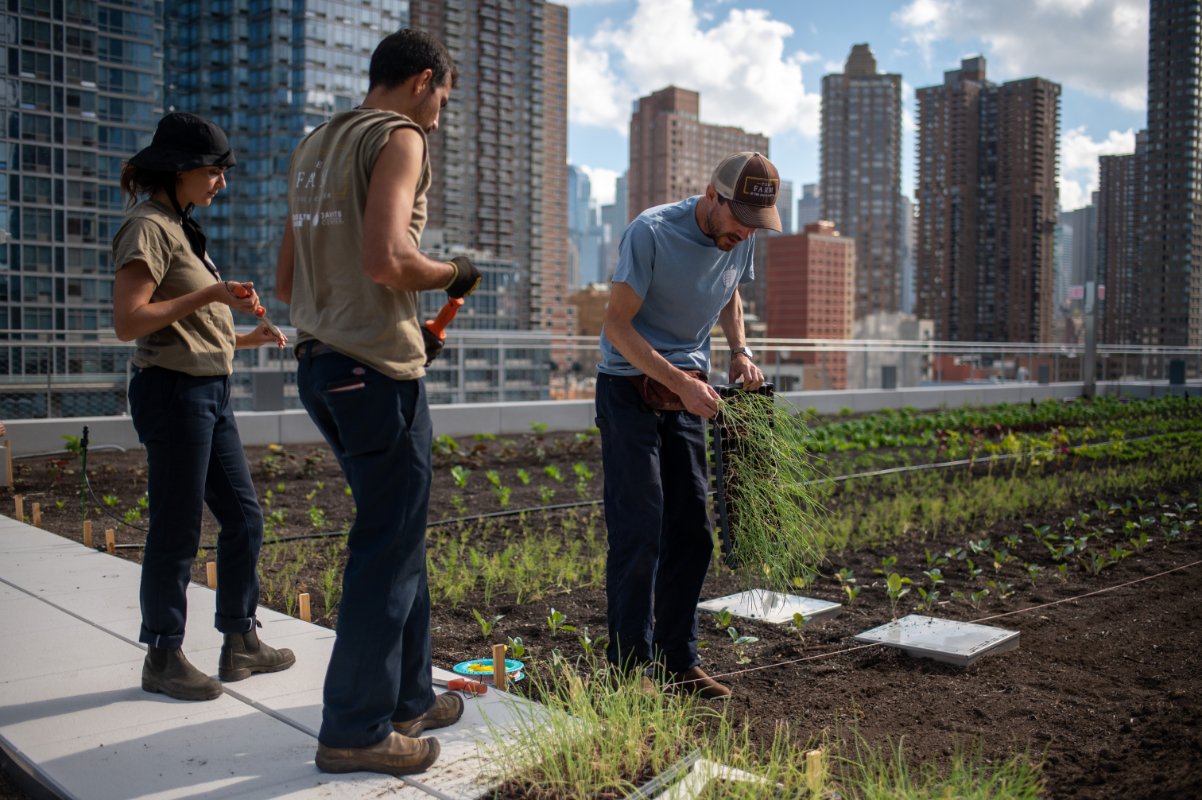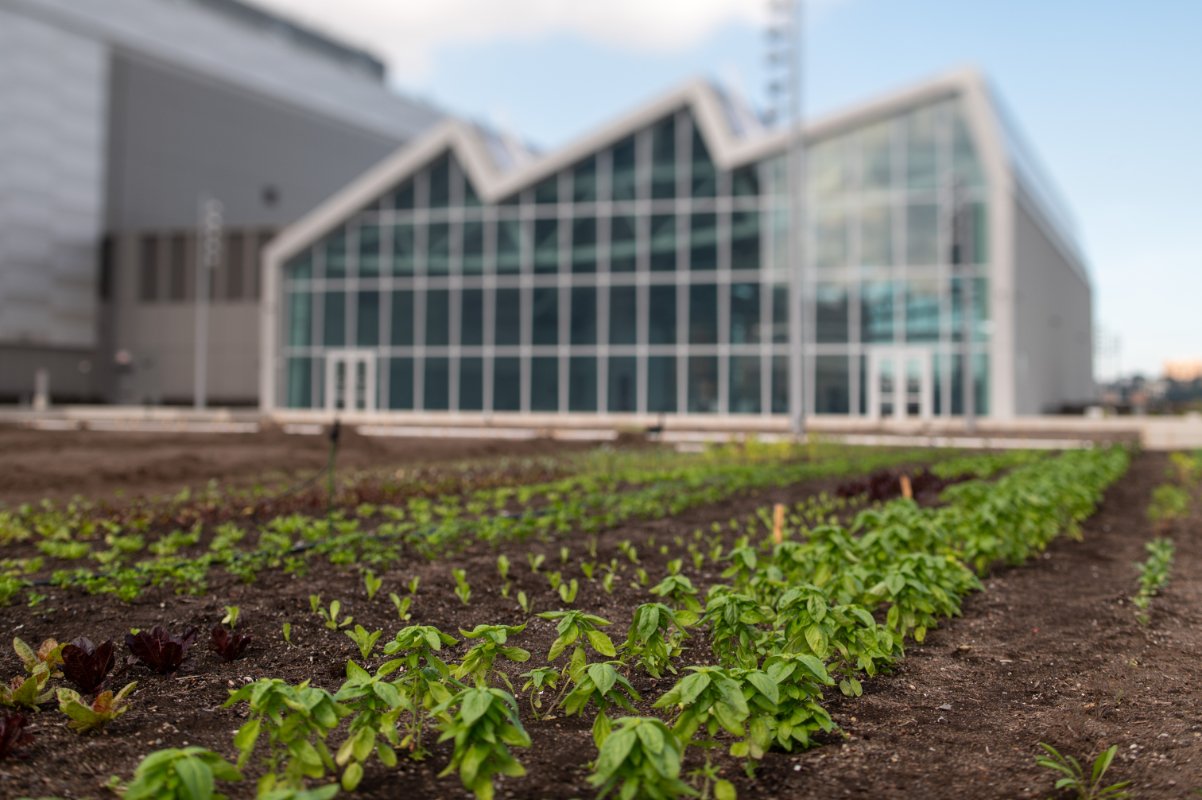Dec 7, 2021
A Farm Grows Atop A Convention Center In NYC

Planting crops at the Brooklyn Grange Rooftop Farm at the Javits Convention Center. (Photo credit: Javits Center)
Editor’s Note: We love seeing and hearing about such iconic urban agricultural projects not only producing thousands of pounds of produce but also helping cities become more resilient. These types of inspirational projects will additionally draw attention from entrepreneurs and existing companies to set up urban agricultural operations and play their part in feeding the world more sustainably. Kickstart your own urban farming dreams by registering for Agritecture Designer today!
CONTENT SOURCED FROM CIVIL EATS
WRITTEN BY BRIDGET SHIRVELL
The Javits Center, home to the city’s largest rooftop green space, expanded in September to include a one-acre farm that will supply its kitchen with fresh food at almost zero food miles.
New York City’s iconic event space at the Javits Center in Manhattan’s Hell’s Kitchen neighborhood shut down during the pandemic and hosted a hospital and mass vaccination site. Now, with apple and pear trees and more than 50 crops growing on its rooftop, it has reopened with in-person events that serve food produced from its own urban farm in hopes of connecting people to how their food is grown.
“We really expect it to be a place where we can grow a decent amount of food in an efficient manner for the convention center,” said Ben Flanner, co-founder and CEO of Brooklyn Grange Rooftop Farm, the company that designed and manages the farm. “It’s a beautiful space, and I think it can be very inspiring from a what-is-possible standpoint for the hundreds of thousands of people that come through the convention center.”

The one-acre farm on the Javits Center’s 200,000 square-foot roof officially opened in September. The Brooklyn Grange team was able to plant and harvest several fall crops, including radishes and salad mixes, for New York Comic Con 2021, which the Javits Center hosted in early October. The Javits Center and Brooklyn Grange—which also operates its own rooftop farms in Brooklyn that produce 100,000 pounds of organic produce each year sold though markets, a CSA program, and wholesale—expect the farm to provide 40,000 fruits and vegetables to be used in Javits Center meals each year.
“We’re very excited for the fact that all the food can be consumed right in the building where it’s being grown,” said Flanner. As the harvest is rolled down the hallway on carts to the kitchen on site, no fossil fuels are consumed for transportation, and the operation virtually eliminates the carbon footprint of packaging. “Nothing needs to be loaded into a van and delivered, and that reduces quite a lot of the logistics,” he adds.
The new rooftop space, which includes the farm, orchard, greenhouse, enclosed glass pavilion, outdoor terrace, and solar panels, was part of a $1.5 billion expansion project at the Javits Center that added 1.2 million square feet of event space. The center, which opened in 1985, installed a 6.75-acre green space on the roof in 2014, which at the time was the second largest in the country and is still the largest green roof in New York. The Javits Center partnered with institutions including Drexel University and the New York City Audubon Society to study the green roof’s effects and documented 35 species of birds and five species of bats that made their homes there. They also added a honey-bee apiary.
“It was just teeming with wildlife,” said Jacqueline Tran, the Javits Center’s energy and sustainability manager.
The team wanted the expansion to build on the biodiversity they were witnessing. “While we thought we could put another green roof on it, we started asking, “How do we push the envelope?’” said Tran. “How do we move it forward?”
The idea for a farm was inspired by the discovery that there used to be a farm in the neighborhood.
While urban agriculture as we think of it today is a relatively new concept, and Brooklyn Grange is only about a decade old, New York City has a long urban farming history. Much of Midtown and the Upper West Side was farmland from the 1700s until the city’s grid of streets was created at the end of the Industrial Revolution in the early 1800s. Agriculture started coming back to the city in the 1970s, with community gardens sprouting up in the Bronx after a series of fires destroyed many of the buildings there.
Today, thousands of pounds of produce are grown in the city every year—in community gardens, urban farms, and indoor vertical farms. The New York City Council recently passed a bill to establish an office of urban agriculture as part of its larger effort to create a Climate Resiliency Plan. The office will be tasked with producing a report on the state of urban agriculture in the city every five years, with the first due in fall 2023.


